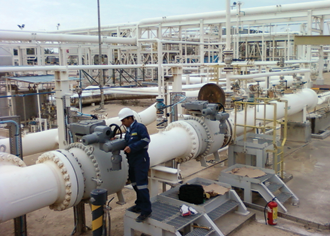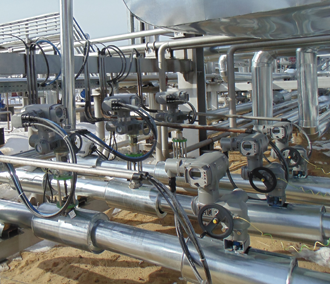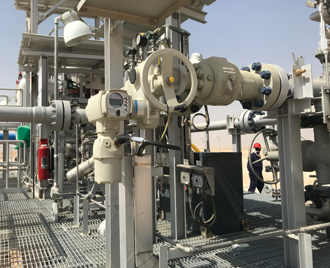In the oil, gas and petrochemical industry, precision control of the flow of product through valves in the system is vital, and modulation of that flow depends on the valve actuator. These critical pieces of equipment must perform reliably and safely under the most extreme conditions: very high and low temperatures, drought or high-rainfall environments, remote situations in deserts or the arctic, and the corrosive effects of chemicals, high humidity or salinity for extended periods. In potentially explosive atmospheres, explosion protection is required; and in some applications, fireproof operation is critical.
In addition to the core function of opening and closing the valve, the actuator forms a crucial interface between the process and the supervisory control system, providing seamless integration into whichever distributed control system (DCS) is used in the plant network. Moreover, where the Industrial Internet of Things (IIoT) plays a role, electric actuators equipped with powerful electronics must serve as information hubs, providing direct access to a wide variety of both process and diagnostics data.
Low cost of ownership for operation and low maintenance is an important factor for distributed systems in plants or along pipelines. Electric actuators are ideal in many industrial applications. The power supply is easy to install and independent of temperature. The actuator is virtually maintenance free. The user interface for the electrical operation of the valve is either remote control through a programmable logic controller/supervisory control & data acquisition (PLC/SCADA) system or is easily accessible using local controls at the actuator. In the case of power failure, a hand wheel is an emergency backup.
Plant and pipeline operations depend on a high degree of valve automation for fundamental functions. The complex processes involved with the flow of material, pumping stations, compressor stations, etc., require the valve positioning to be accurate and extremely reliable.
Actuators must operate the full range of valves—from ball valves, butterfly valves, gate valves to others—to control the flow of both gas and liquids. Typically, ball or butterfly valve actuation requires part-turn actuators that provide a swivel movement of generally 90 degrees for full travel. Gate valves, on the other hand, typically need multi-turn actuators that provide a high number of turns to operate the valve from open to close and vice versa.
Another differentiation is the type of duty the actuator has to perform, whether that’s open/close or modulating. Actuators used to isolate a segment, allow maintenance or interruptions in the process, or in worst case stop a leak, are required to operate infrequently to open or close shut-off valves.
Modulating actuators, on the other hand, provide enhanced positioning accuracy for control valves to precisely modulate the flow within pipes. In the upstream segment, this is for the flow of crude oil and natural gas; in the midstream segment, it’s for the storage and transportation of resources. In the downstream segment, this is for the refining process of crude oil, as well as the sale and distribution of both the refined product (i.e., gasoline, fuel, asphalt, etc.) and to feed raw materials to a variety of petrochemical industries that use petroleum-based products to make plastics, fertilizers, pharmaceuticals and more.
MODULAR ACTUATOR APPROACH
A modular actuator concept meets these varying demands with a number of standard components. A wide range of multi-turn and part-turn actuators would be available to be configured for different torque values, power supply sources, types of valve attachments, etc. At the control level, the choice may be between basic or intelligent actuator controls based on what provides the most cost-efficient solution for simple to the most complex process control challenges.
Modular design, combined with flexible actuator geometry, allows easy onsite adjustment of mounting positions. This ensures the operating elements such as local controls and display are always easily accessible, even in tight spaces.
As an additional benefit, a modular concept dramatically reduces the number of spare parts. Only a few standard, core components and interchangeable parts need to be kept by the end user for a quick turnaround and short downtime.
Pipeline applications often involve opening and closing large valves, which requires very high torque. Combining actuators with a complement gearbox portfolio addresses this need: These solutions achieve torques of up to 500,000 foot-pounds (675,000 Nm).
ESSENTIAL CORROSION PROTECTION
In the oil and gas industry, it’s highly important that valves operate reliably regardless of process conditions. From coastal areas to the tropics and deserts to the arctic regions, harsh environmental conditions and corrosion can cause significant downtime and serious cost. Humid or salty atmospheres are damaging environments. Ambient temperatures can easily range from -76°F to 150°F (-60°C to 70°C) so it is vital that electric actuators selected for this service can resist these environmental conditions. Enclosure protection (NEMA 4X/6P [National Electrical Manufacturers Association] and IP68 [Ingress Protection] in compliance with NEMA 250 and EN 60529) is a key requirement for actuators to resist humidity and dust.
In coastal areas and offshore applications, actuators should meet the requirements for the highest corrosivity categories C5-M long, in accordance with EN ISO [International Organization for Standardization] 12944-6 (Paints and Varnishes–Corrosion Protection of Steel Structures by Protective Paint Systems). This is especially essential for subsea pipelines where the compressor stations on both ends of the subsea portion are exposed to a highly saline atmosphere.
One feature used to meet these challenges is advanced powder coatings, which can be applied to the individual housing parts before assembly. The coating also can be used on the output flange and extend beyond the sealing edge of the joints. This means that the coating would remain intact even if the actuator is removed from the valve or if the housing is opened during installation or commissioning.
Where cathodic protection is in operation, an additional cathodic insulator can be added to the actuator housing such as integrated laminated fabric components between the actuator and the valve, so the cathodic current flow does not reach the actuator housing.
CLASSIFIED, HAZARDOUS AREAS
Handling combustible gases, vapors or dusts requires the utmost caution and safety features to avoid hazards for people and assets. Electric actuators used in these areas must be certified. The oil and gas and petrochemical industries are a global market with various certifications, depending on the country or region (Examples are FM in the U.S., CSA and ATEX in Europe, IECEx in several areas, etc.) For maximum safety, plant engineers specify devices that provide explosion protection in compliance with the standards and directives for the final location of the installation.
Explosion-proof actuators are designed so they will not become an ignition source for a potentially explosive atmosphere. They will neither generate sparks nor hot surfaces. All the electrical, mechanical and electronic components of the actuator are integrated into a single housing, providing an internationally approved solution for maintaining the proper separation from potentially hazardous parts and an explosive atmosphere, using a flameproof enclosure. If a combustible gas or vapor would penetrate the enclosure, that enclosure must be able to withstand the pressure that can develop during an internal explosion.
OPERATION IN CRITICAL SITUATIONS
Additional requirements in the oil and gas industry may be called for such as fireproof versions of actuators that reliably maintain all functionality even during the direct impact of fire. In the event of a fire, the enclosure absorbs the heat and ensures reliable actuator operation ensuring that the valve still functions.
Assessment of possible risks emanating from a process can lead to the implementation of safety instrumented systems (SISs) fulfilling high functional safety requirements. Electric actuators that accomplish safety functions such as safe emergency shutdown and safe stop are frequently used in such systems. Today, actuators are available that are TÜV-certified for safety-related applications up to a safety integrity level (SIL) of SIL 3, according to EN 61508 (Functional Safety of Electrical/Electronic/Programmable Electronic Safety-Related Systems).
INTEGRATION WITH INTELLIGENT CONTROLS
The latest developments also include interfaces for the Industrial Ethernet Standards Profinet and Modbus TCP/IP. Thanks to an unprecedented connectivity and real-time data transmission, these standards are especially suitable for integrating actuators into IIoT [Industrial Internet of Things] applications. Electric valve actuators can play a key role in these systems. On the one hand, they operate remotely, opening and closing valves. On the other hand, other, powerful electronics allow electric actuators to act as information hubs for both process-related data (i.e. valve position feedback), and actuator-related data, based on advanced self-diagnostics. For instance, intelligent algorithms monitor actuator characteristics to indicate when maintenance should be carried out.
Plant-wide asset management based on device-specific data can boost reliability and reduce unexpected downtime. All information is directly available on the network and can be used for process visualization, statistics, advanced modeling or simulation to improve process performance.
OPTICAL FIBER COMMUNICATION
To manage long distances between devices, data transmission via optical fibers can present a viable solution. There is low attenuation of signals in optical fiber cables and, unlike copper cables, optical fiber is immune to electromagnetic interference so separate installation of signal and power cables is not needed.
INTERNATIONAL PROJECTS
For international projects, cooperation between major stakeholders (including national governments, international businesses, and engineering, procurement, construction firms) means projects are specified in one country, but actuators are mounted to valves at the valve supplier’s workshop in a second place, and then installed in a third location. Because of this, it is vital that local support be available for global projects.
THE FUTURE FOR PLANT MONITORING
The challenges and opportunities presented by IIoT and big data are complex, but at their heart lays a simple truth: The flow of oil and gas, and the processes along the way will all be expressed as data with ever-increasing granularity. Where there is data, that data can be used and manipulated.
Once everything is measurable, and data security and internet reliability issues are fully addressed, new ways of using that data and instrumentation integration will emerge. Actuators, because they are present throughout any distributed flow process, will be key enablers in the data revolution to come.
GUENTER HUBER is product manager for AUMA Actuators, Inc. (www.auma-usa.com). Reach him at Guenter.huber@auma-usa.com.
RELATED CONTENT
-
Rigging and Lifting of Large Valves
This article outlines the challenges of lifting large valve assemblies weighing several tons and illustrates the industrial rigging equipment and lifting operations typically used for these valves.
-
Introduction to Pressure Relief Devices - Part 1
When the pressure inside equipment such as boilers or pressure vessels increases beyond a specified value, the excess pressure may result in a catastrophic failure.
-
The Rationale Behind Valve Characteristics
Back in the “early days,” we were taught that, to properly control flow, we should select a linear valve characteristic when the valve controls more than 25% of the piping system pressure drop at full flow.














 Unloading large gate valve.jpg;maxWidth=214)